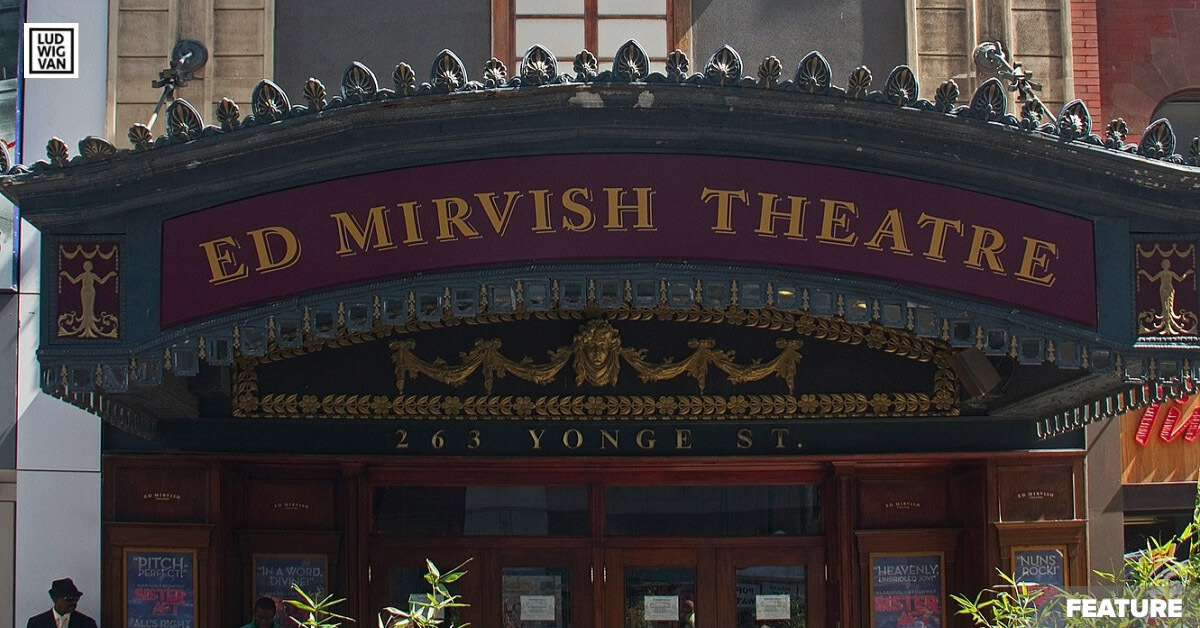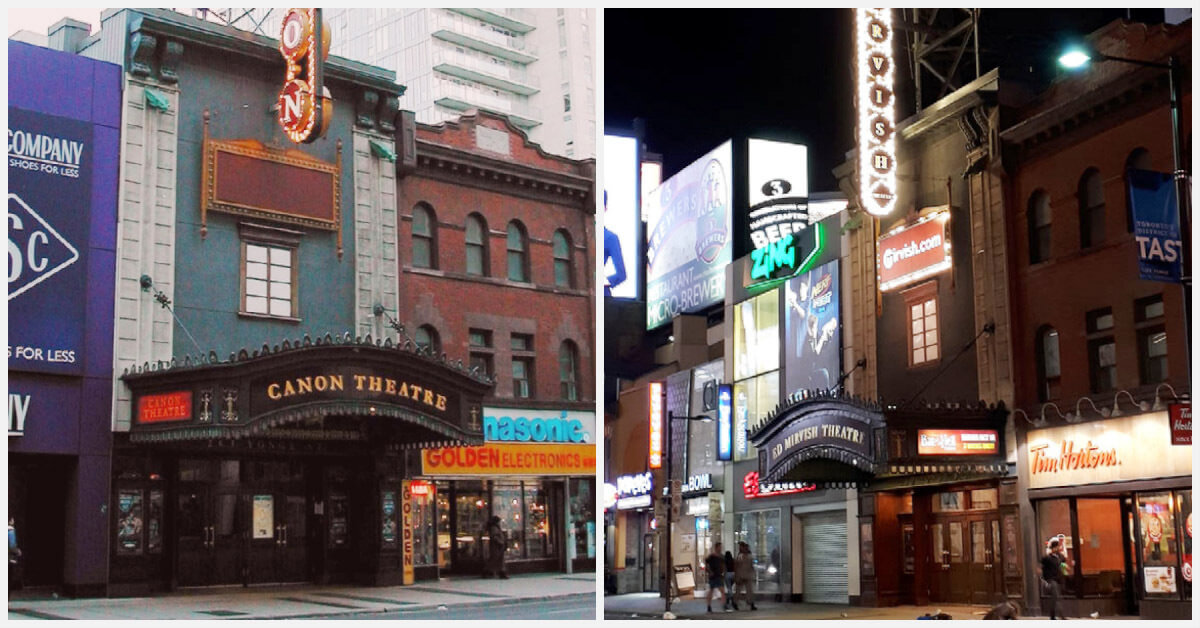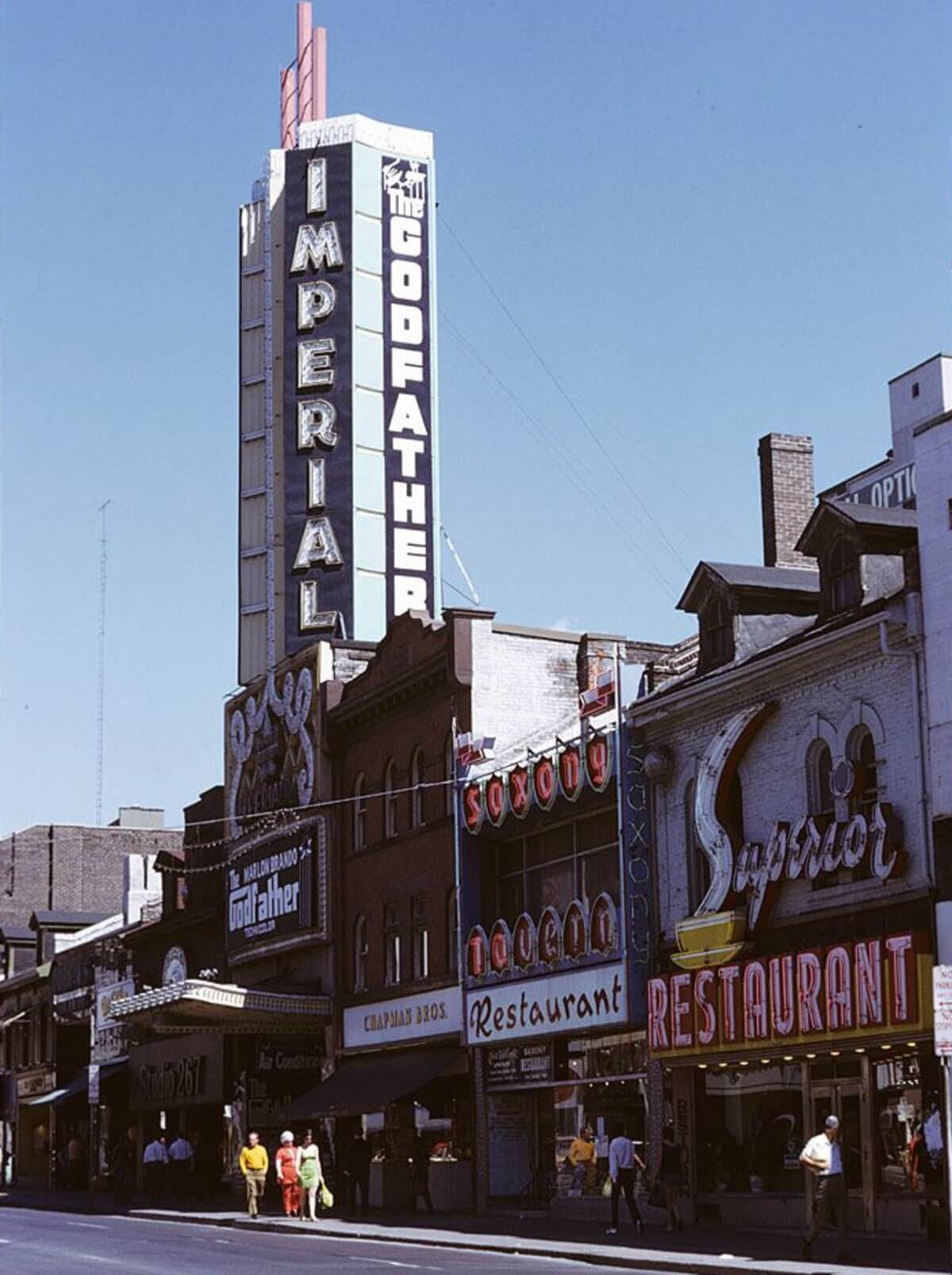
Scandal, international legal dramas and corporate skulduggery – the history of the Canadian movie distribution business is a roller coaster of ambition and bitter rivalries that dates back to the early days of cinema itself.
The historic Ed Mirvish Theatre on Yonge Street in Toronto is at the very heart of the story.
The Art Deco Period Of Canadian Movie Theatres: Grand Ambitions And Sordid Scandals
Now known as the Ed Mirvish Theatre, when the Art Deco structure opened on Yonge Street in 1920, it was called the Pantages Theatre. The building was designed by renowned theatre architect Thomas W. Lamb, responsible for the building that now houses the Boston Opera House, and the Elgin and Winter Garden Theatres. It was the biggest movie theatre in Canada at the time, with 3,373 seats.
While it operated successfully with a combination of vaudeville and movie screenings for about a decade, its next turn of fate would come in the form of a sex scandal.
Born on a Greek island, Alexander Pantages rapidly rose to the top of the theatre circuit chain in North America in the early decades of the 20th century. By the 1920s, the Pantages chain owned 84 theatres across North America, specializing in vaudeville. Around the same time, however, rumours began of a troubled marriage and trips to Mexico with teenage girls. In 1929, he’d make a mistake that proved fatal to his business ventures, among other things. He agreed to meet a 17-year-old vaudeville performer named Eunice Irene Pringle for a private audition. She came running out of his office a half hour later with her dress ripped and screaming that she’d been sexually assaulted.
The story was big news internationally, and became both a personal and business ruin for Pantages. There were even wild and unsubstantiated rumours in the press that Joseph P. Kennedy had paid her to trump up an accusation so that he could buy out the Pantages chain. Pantages was convicted in 1929, but later acquitted in a 1931 appeal. The damage, though, had been done.
The building was bought by RKO Pictures (owned by Kennedy, to add fuel to the rumors), and along the way, management and control was transferred to Famous Players. The Pantages became The Imperial, then The Imperial Six (with six screens) in 1973. The interior was redesigned for movie audiences with a modern look, and the theatre screened major releases through the 1970s and into the 1980s.
That’s when it became caught up in a bitter corporate rivalry that requires a bit of history to piece together.

Famous Players Vs. Odeon Vs. Cineplex
While the Pantages/Imperial/Ed Mirvish Theatre building was designed by Lamb, it was financed by movie distribution pioneer Nathan L. Nathanson, who owned the independent Paramount Theatre chain.
Famous Players was founded in 1912, but its Canadian history dates back to 1920, when FP bought out the Paramount Theatre chain from Nathanson. Toronto born businessman Nathan Louis Nathanson was the 5th richest person in the world at the time, and he became the first president of the Famous Players Canadian Corporation Limited, the subsidiary that arose from the merger.
In 1923, Famous Players took over the Allen Brothers Theatres and became the preeminent movie distributor in Canada.
However, Nathanson, in the meantime, was secretively acquiring other theatres outside the FP chain. In 1941, he resigned, and joined British owned Odeon Theatres where his son Paul was already established. (As a peripheral note, Nathanson also sat on the CBC’s original board of directors in 1936, and became its Vice-President four years later.)
Cineplex is a more modern company, but also with deep roots in the Canadian theatre biz.
Nat Taylor had founded 20th Century Theatres in 1934. Despite its status as an independent, coming in third after the Famous Players and Odeon chains, he did a respectable business, and by 1941, was operating 17 theatres of his own, along with another 25 in an agreement with Famous Players. The FP agreement was largely constructed to prevent Taylor from selling to Odeon, and the strategy worked. By the 1970s, Taylor had sold most of his chain directly to FB.
That’s when he decided to start a new movie theatre chain with young Toronto entertainment lawyer Garth Drabinsky. They formed Cineplex Cinemas, ushering in a new era of corporate innovation, bitter rivalry, and high drama.
The now Ed Mirvish Theatre interior in 2014:
Garth Drabinsky And The 1980s
It was Drabinsky who ushered in the era of multiscreen theatres with an upscale lobby and more to offer taste buds than popcorn and candy.
When Drabinsky and his partner Nat Taylor opened the world’s first Cineplex in the basement of Toronto’s Eaton Centre in 1979, its 18 screens made it a Guinness world record. He also invested in larger screens and high tech Dolby sound systems throughout the chain.
Taylor had experimented with multiscreen theatres as early as 1948, but the new Cineplex made history. At first, the location played largely art house and European films, and the competition didn’t take the new idea too seriously. But, Drabinsky’s innovations were later used to create the contemporary movie theatre model with its multiple screens, plusher seating, and diverse food options.
By the mid-1980s, Famous Players was owned by Gulf + Western Inc., which also owned Paramount Pictures. FP also had arrangements with most of the large American studios, including Warner Bros., MGM-United Artists and Walt Disney Co.’s Buena Vista Canada Inc., clearly putting Cineplex at a disadvantage.
Drabinsky’s legal background came in handy, and he was able to put enough pressure on regulators that the major American distributors agreed to a more equitable competition model. The Bronfman family of Montreal became major investors when Cineplex bought out the Odeon chain in 1984. Drabinsky became chairman of Cineplex Odeon Corp.

The Fall Of The Imperial Six – And The Rise Of The Pantages Theatre Reincarnated
The Imperial Six theatre was actually sprawled over three separate lots with different owners. Famous Players owned the Yonge Street entrance, and the front half of the building. The remainder of the property it stood on was leased from a private family holding.
While attempting to renegotiate the terms of the lease in 1986, Famous Players made the fatal mistake of letting the agreement lapse.
The company that owned the land contacted Cineplex Odeon directly to offer them up a new lease, and Drabinsky himself flew to Michigan to sign the deal. It gave him control of the lobby, four of the six projection booths, Cinema 2 in its entirety, and the back half of two of the other cinemas. Famous Players, denied access to most of the theatre, took Cineplex to court, but the Supreme Court of Ontario struck down their injunction.
While they attempted many different configurations in order to stay in business, FP eventually had to content themselves with a single screen moviehouse, the Pantages Cinema, with an entrance on Victoria Street.
The rivalry boiled over at the opening of the Pantages Cinema in 1987 for a screening of Wall Street. Famous Players contacted the fire marshal’s office with a complaint that the Pantages’ fire exits were still under construction. It proved to be true, and the gala had to be moved to a different location at the last minute. Crews worked overnight to get the fire exits done in time for the movie premiere.
The move also caused a ripple effect that was felt back in corporate HQ in the US, where long-time President George Destounis was ousted from Famous Players for the loss of the Imperial Six, its flagship cinema in Canada.
After not much success, FP sold The Pantages Cinema to Cineplex – but with the stipulation that it never again be used as a movie theatre. In a twist of historic irony, Cineplex renovated the building for live theatre, and renamed it Pantages Theatre. Its new story began – but with a few more corporate twists in the mix.
Drabinsky’s Golden Parachute
In 1986, Drabinsky sold 49 percent of Cineplex Odeon to MCA Inc. MCA was the parent company of Universal Studios. In 1989, apparently, he had second thoughts, and attempted to buy it back. After a lot of high profile legal wrangling, in the end Drabinsky was not able to get the financing, and he was forced out of the company with a healthy multi-million dollar severance package.
That golden parachute also included the Imperial Theatre building, along with the Canadian rights to The Phantom of the Opera. The rest – a decade long run of the musical in the restored Art Deco structure – is Canadian theatre history.
Coda
In a coda to the dramatic corporate story, Drabinsky would later be convicted of fraud and forgery after the dissolution of his new entertainment company, Livent, in the late 1990s. He was released from prison in 2014.
After the end of Livent, in 1999, The Pantages Theatre was bought by Clear Channel, which, through its subsidiary Live Nation, subsequently turned management of the facility over to Mirvish Productions. Mirvish also has right of first negotiation should the building ever go for sale.
The theatre, still used for live performances, was renamed the Canon Theatre in 2001 for sponsorship purposes, and then renamed again in 2011 after the late Toronto theatre impresario Ed Mirvish. In another twist of fate, Ed Mirvish, for a time, was Garth Drabinsky’s main rival in the Toronto live theatre scene.
In the end, it was corporate takeovers that put an and to the business rivalry. Famous Players was acquired by Viacom as a subsidiary of Paramount Communications in 1994.
Cineplex Odeon merged with Galaxy Entertainment in 2003, creating a new company called Cineplex Galaxy. Cineplex Galaxy, in its turn, bought Famous Players the following year from Viacom (2004). The end result was Cineplex Entertainment, which now controls 165 of the movie theatres across Canada for more than 75 percent of the market.
Further acquisitions led to the buyout of Cineplex by British company Cineworld in 2019. The era of big personalities in Canadian movie distribution seems to have subsided.
#LUDWIGVAN
Get the daily arts news straight to your inbox.
Sign up for the Ludwig van Daily — classical music and opera in five minutes or less HERE.
- INTERVIEW | Composer Ari Kinarthy And Director Jeff Lee Petry Talk About Ari’s Theme, Premiering At Hot Docs - April 26, 2024
- PREVIEW | Creators & Performers Natalya Gennadi And Kristine Dandavino Talk About Grandma’s Shawl - April 26, 2024
- PREVIEW | Artistic Director Emily Cheung Dives Into Little Pear Garden Dance Company’s History & 30th Anniversary Peformance - April 26, 2024



